Whether you’re just getting into AI or you’re already deep in machine learning, computer vision is one area that’s seriously exciting – and growing fast. But with so many books out there, it’s tough to know where to start or what’s worth your time. That’s why we’ve rounded up the best computer vision books for all levels, from beginner-friendly guides to advanced texts packed with real-world examples. Let’s ssdive in.

Applications of Computer Vision and AI Superior’s Experience
Computer vision, a transformative field within artificial intelligence, empowers machines to interpret and act on visual data, revolutionizing industries worldwide – from autonomous vehicles navigating complex roads to medical imaging systems detecting anomalies, computer vision applications are vast and impactful. AI Superior exemplifies the practical application of computer vision in solving real-world challenges. Specializing in tailored AI solutions, our company has delivered innovative projects, such as a drone-based litter detection system for a semi-government organization. This GIS-based application used computer vision to identify litter from aerial images, optimizing trash collection routes, reducing costs by 50%, and improving detection accuracy by 7% compared to human experts. Another project involved AI style transfer for medical imaging, enabling the reuse of existing machine learning models across different image domains. These initiatives highlight AI Superior’s expertise in object detection, image analysis, and process automation, serving industries like manufacturing, healthcare, and public services.
AI Superior’s work in industrial automation includes quality assurance systems that detect defects in manufacturing processes, streamlining production and reducing waste. Our solutions also extend to smart cities and retail, where real-time video processing and predictive analytics enhance operational efficiency. By integrating computer vision with IoT and machine learning, AI Superior drives innovation, helping clients achieve scalability and competitive advantages.
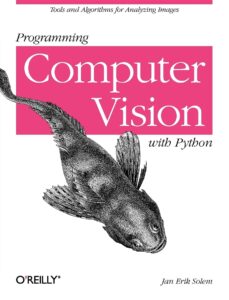
1. Programming Computer Vision with Python: Tools and Algorithms for Analyzing Images by Jan Erik Solem
Programming Computer Vision with Python: Tools and Algorithms for Analyzing Images by Jan Erik Solem is a practical guide for those interested in the field of computer vision. This hands-on book provides a comprehensive introduction to computer vision techniques, including object recognition, 3D reconstruction, stereo imaging, and augmented reality, all implemented using Python. The author, Jan Erik Solem, is a Python enthusiast and a computer vision researcher and entrepreneur, with experience as an associate professor and startup CTO. He has used Python for computer vision in teaching, research, and industrial applications for many years . The book includes complete code samples with explanations on how to reproduce and build upon each example, along with exercises to help readers apply what they’ve learned. It’s designed for students, researchers, and enthusiasts with basic programming and standard mathematical skills.
What Will You Learn:
- Core image processing techniques, including filtering, segmentation, and feature detection.
- Advanced topics like image stitching, object recognition, and 3D modeling using Python.
- Practical use of Python libraries such as NumPy, PIL, and SciPy for vision tasks.
Who is This Book For:
- Beginners in computer vision with basic Python knowledge seeking a hands-on introduction.
- Intermediate programmers or researchers wanting to apply vision algorithms to real-world problems.
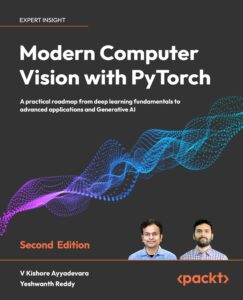
2. Modern Computer Vision with PyTorch by V Kishore Ayyadevara and Yeshwanth Reddy
Modern Computer Vision with PyTorch: Explore Deep Learning Concepts and Implement Over 50 Real-World Image Applications by V Kishore Ayyadevara and Yeshwanth Reddy is a comprehensive guide that bridges foundational neural network principles with advanced computer vision (CV) techniques. The second edition, released in June 2024, offers an updated roadmap through state-of-the-art architectures, including transformers and diffusion models, tailored for real-world applications. With over 50 practical projects, readers can delve into tasks ranging from image classification and object detection to generative modeling and multimodal AI. The authors, both seasoned data scientists, provide insights into deploying models using tools like FastAPI and Docker, ensuring a holistic understanding from model development to production deployment. Accompanied by accessible code on GitHub and compatibility with Google Colab, this book serves as a valuable resource for those looking to harness PyTorch for CV challenges.
What Will You Learn:
- Deep learning fundamentals, including CNNs, RNNs, and transfer learning for vision tasks.
- Implementation of over 50 applications, such as facial recognition and image generation.
- Advanced techniques like GANs, transformers, and reinforcement learning in vision.
Who is This Book For:
- Intermediate Python programmers with basic machine learning knowledge.
- Data scientists and engineers aiming to specialize in deep learning for computer vision.
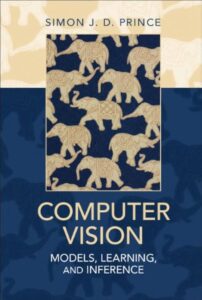
3. Computer Vision: Models, Learning, and Inference by Simon J. D. Prince
Computer Vision: Models, Learning, and Inference by Simon J. D. Prince is a comprehensive and mathematically rigorous exploration of modern computer vision through the lens of probabilistic modeling. Published by Cambridge University Press, this 598-page textbook offers a self-contained introduction that begins with foundational concepts in probability and model fitting, gradually advancing to complex vision systems. Prince’s approach emphasizes the use of training data to learn relationships between observed images and aspects of the world, such as 3D structures or object classes, enabling readers to make new inferences from novel image data . The book’s clarity and depth have been praised by experts in the field, including William T. Freeman of MIT, who described it as “a beautiful book, showing everything clearly and intuitively,” and David J. Fleet of the University of Toronto, who noted its value for both students and researchers . With over 350 full-color illustrations and more than 70 algorithms described in sufficient detail for implementation, this text serves as both an educational resource and a practical guide for those seeking to understand the mathematical foundations of computer vision
What Will You Learn:
- Probabilistic models for vision, including Bayesian methods and graphical models.
- Techniques for image classification, object detection, and scene understanding.
- Inference algorithms like Markov chain Monte Carlo and variational methods.
Who is This Book For:
- Graduate students and researchers in computer vision or machine learning.
- Professionals with strong mathematical backgrounds seeking theoretical insights.
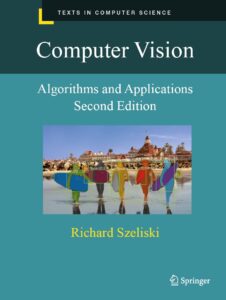
4. Computer Vision: Algorithms and Applications by Richard Szeliski
Computer Vision: Algorithms and Applications by Richard Szeliski is a comprehensive and authoritative textbook that delves into the diverse techniques used to analyze and interpret images. The book not only covers foundational concepts but also explores challenging real-world applications, such as image search, autonomous navigation, and augmented reality. Szeliski adopts a scientific approach to formulating computer vision problems, analyzing them using the latest classical and deep learning models, and solving them with rigorous engineering principles. The second edition incorporates new material on deep learning and applications like mobile computational photography, autonomous navigation, and augmented reality. With over 1,500 new citations and 200 new figures, the book reflects the significant developments in the field over the past decade. Structured to support active curricula and project-oriented courses, it includes exercises at the end of each chapter, emphasizing algorithm testing and offering suggestions for mid-term projects. Additional materials and detailed mathematical topics are provided in the appendices, covering linear algebra, numerical techniques, estimation theory, datasets, and software .
What Will You Learn:
- Core vision techniques, including image formation, feature detection, and stereo vision.
- Advanced topics like motion estimation, 3D reconstruction, and deep learning applications.
- Practical insights into vision applications in robotics, medical imaging, and more.
Who is This Book For:
- Students and educators seeking a comprehensive computer vision textbook.
- Professionals needing a reference for vision algorithms and applications.
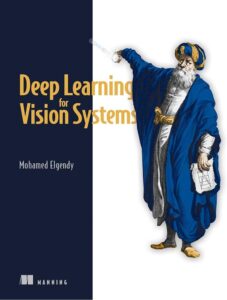
5. Deep Learning for Vision Systems by Mohamed Elgendy
Deep Learning for Vision Systems by Mohamed Elgendy is a hands-on guide that bridges the gap between theoretical deep learning concepts and practical computer vision applications. Published by Manning Publications in 2020, this 480-page book offers a structured approach to building intelligent, scalable vision systems capable of interpreting and reacting to visual data in real-world scenarios. Elgendy, a seasoned AI expert with experience at Amazon and Twilio, leverages his industry knowledge to present complex topics in an accessible manner, requiring only a foundation in high school algebra. The book is enriched with real-world projects and illustrations, making it a valuable resource for those aiming to understand and implement state-of-the-art deep learning techniques in computer vision. Topics covered include image classification, object detection, generative models, and visual embeddings, providing readers with a comprehensive toolkit for developing advanced vision applications. With its practical focus and clear explanations, this book serves as both an educational resource and a practical guide for aspiring computer vision practitioners.
What Will You Learn:
- Fundamentals of deep learning, including CNNs and transfer learning.
- Techniques for image classification, object detection, and semantic segmentation.
- Practical model deployment using TensorFlow and Keras.
Who is This Book For:
- Programmers with basic Python and machine learning knowledge.
- Engineers and data scientists focused on building vision-based applications.
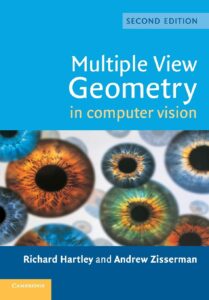
6. Multiple View Geometry in Computer Vision by Richard Hartley and Andrew Zisserman
“Multiple View Geometry in Computer Vision” is a seminal work that delves into the mathematical foundations of computer vision, particularly focusing on the geometry of multiple views. Authored by Richard Hartley and Andrew Zisserman, the book provides a comprehensive treatment of projective geometry and its applications in computer vision. It covers essential topics such as camera calibration, epipolar geometry, and 3D reconstruction, offering rigorous mathematical derivations alongside practical algorithms. The second edition includes updated content reflecting the latest advancements in the field. With numerous illustrations and examples, the book aids in visualizing complex concepts. It serves as both a textbook for students and a reference for researchers and professionals. The authors’ expertise ensures a deep and thorough exploration of the subject matter. This book is widely regarded as a cornerstone in the study of computer vision geometry.
What Will You Learn:
- Core concepts of projective geometry and epipolar constraints.
- Algorithms for 3D reconstruction, camera calibration, and stereo vision.
- Techniques for structure-from-motion and multi-view correspondence.
Who is This Book For:
- Graduate students and researchers in computer vision or robotics.
- Professionals working on 3D vision applications requiring geometric expertise.
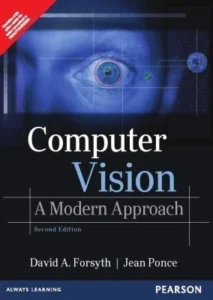
7. Computer Vision: A Modern Approach by David Forsyth and Jean Ponce
“Computer Vision: A Modern Approach” by David Forsyth and Jean Ponce offers a comprehensive introduction to the field of computer vision. The book balances theoretical foundations with practical applications, covering topics such as image formation, feature detection, and object recognition. It integrates mathematical rigor with real-world examples, facilitating a deeper understanding of complex concepts. The authors emphasize the development of algorithms that enable machines to interpret visual information. With a focus on both low-level and high-level vision tasks, the book provides insights into the challenges and solutions in the field. Extensive illustrations and exercises enhance the learning experience. This text is widely used in academic courses and serves as a valuable resource for practitioners. Its modern approach reflects the evolving landscape of computer vision research and applications.
What Will You Learn:
- Fundamental vision concepts, including image formation and feature extraction.
- Techniques for object recognition, motion analysis, and scene understanding.
- Mathematical foundations of vision algorithms and models.
Who is This Book For:
- Undergraduate and graduate students studying computer vision.
- Educators and researchers needing a comprehensive reference.
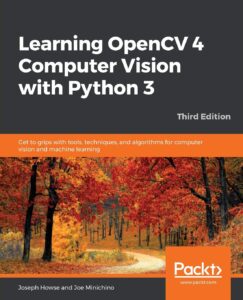
8. Learning OpenCV 4 Computer Vision with Python 3 by Joseph Howse and Joe Minichino
“Learning OpenCV 4 Computer Vision with Python 3” is a practical guide to building computer vision applications using OpenCV and Python. The book covers fundamental concepts such as image processing, video analysis, and machine learning techniques. It provides step-by-step instructions for setting up OpenCV with Python and developing real-world applications. Topics include face detection, object tracking, and augmented reality. The author emphasizes hands-on learning, offering numerous code examples and exercises. Updated for OpenCV 4, the book reflects the latest features and best practices. It serves as an accessible introduction for beginners and a useful reference for experienced developers. By the end, readers will have the skills to implement their own computer vision projects.
What Will You Learn:
- Core OpenCV techniques, including image processing and feature detection.
- Advanced applications like face recognition, object tracking, and augmented reality.
- Python-based implementation of OpenCV 4’s latest features.
Who is This Book For:
- Beginners with basic Python skills new to computer vision.
- Developers seeking to build practical vision applications with OpenCV.
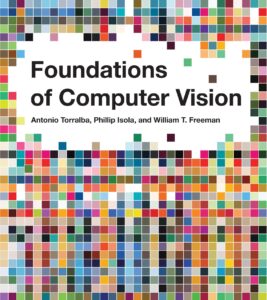
9. Foundations of Computer Vision by Antonio Torralba, Phillip Isola, and William T. Freeman
“Foundations of Computer Vision” offers a comprehensive introduction to the principles and techniques underlying the field of computer vision. The book emphasizes the development of algorithms that enable machines to interpret visual information from the world. It covers a range of topics, including image formation, feature detection, segmentation, and object recognition. In book authors integrate mathematical rigor with practical applications, providing readers with both theoretical insights and hands-on experience. The text is enriched with numerous illustrations and examples that aid in understanding complex concepts. Designed for students and professionals alike, the book serves as both a textbook and a reference guide. Its structured approach facilitates a deep understanding of the subject matter. By bridging the gap between theory and practice, this work stands as a valuable resource in the study of computer vision.
What Will You Learn:
- Deep learning techniques, including CNNs, transformers, and generative models.
- Core vision tasks like image classification, segmentation, and object detection.
- Insights into emerging trends like self-supervised learning and vision-language models.
Who is This Book For:
- Students and educators seeking a modern computer vision curriculum.
- Researchers and professionals exploring deep learning in vision.
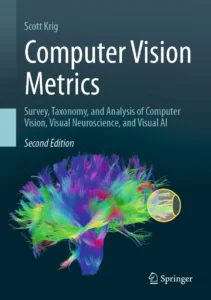
10. Computer Vision Metrics: Survey, Taxonomy, and Analysis by Scott Krig
“Computer Vision Metrics” by Scott Krig provides an in-depth analysis of the evaluation metrics used in the field of computer vision. The book offers a comprehensive survey of techniques and methodologies for assessing the performance of vision systems. It categorizes and analyzes various metrics, providing a taxonomy that aids in understanding their applications and limitations. Krig emphasizes the importance of selecting appropriate metrics for different tasks, such as image classification, object detection, and segmentation. The text is enriched with case studies and examples that illustrate the practical implications of metric selection. Designed for both practitioners and researchers, the book serves as a guide for developing and evaluating computer vision algorithms. Its structured approach facilitates a deeper understanding of performance assessment in visual computing. By bridging theoretical concepts with practical applications, this work stands as a valuable resource in the study of computer vision metrics.
What Will You Learn:
- Comprehensive taxonomy of vision metrics and feature descriptors.
- Techniques for evaluating image processing and recognition algorithms.
- Practical methods for optimizing vision system performance.
Who is This Book For:
- Engineers and researchers focused on algorithm evaluation and optimization.
- Advanced students studying performance metrics in computer vision.
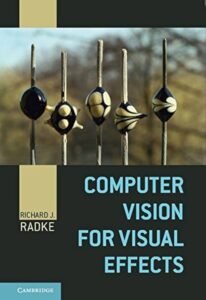
11. Computer Vision for Visual Effects by Richard J. Radke
“Computer Vision for Visual Effects” by Richard J. Radke explores the intersection of computer vision and visual effects in film and television. The book delves into the algorithms and techniques used to integrate computer-generated imagery with live-action footage. Topics covered include camera tracking, 3D reconstruction, image-based rendering, and motion capture. Radke emphasizes practical applications, providing insights into the challenges and solutions encountered in the visual effects industry. The text is enriched with examples from real-world projects, illustrating the implementation of computer vision techniques in production environments. Designed for students and professionals, the book serves as both an educational resource and a reference guide. Its structured approach facilitates a comprehensive understanding of the role of computer vision in visual effects. By bridging the gap between theory and practice, this work stands as a valuable asset in the study of visual computing.
What Will You Learn:
- Techniques for motion capture, camera tracking, and image-based rendering.
- Algorithms for 3D scene reconstruction and compositing in visual effects.
- Practical applications of vision in film and game production.
Who is This Book For:
- Computer vision researchers interested in visual effects applications.
- VFX artists and filmmakers seeking technical vision knowledge.
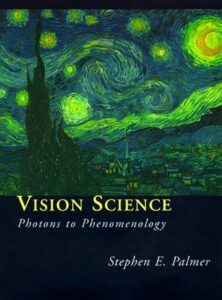
12. Vision Science: Photons to Phenomenology by Stephen E. Palmer
Stephen E. Palmer’s Vision Science: Photons to Phenomenology is a seminal work that bridges the gap between the physics of light and the psychology of visual perception. Published by MIT Press, this comprehensive text explores how visual information is processed from photons hitting the retina to the brain’s interpretation of complex scenes. Palmer’s interdisciplinary approach integrates optics, neurophysiology, and cognitive science, making it a cornerstone for understanding vision. The book’s clear explanations and rigorous scientific grounding have earned it praise as a definitive resource in vision research. Its engaging style appeals to both newcomers and seasoned researchers. With detailed diagrams and a focus on phenomenology, it remains a vital reference for studying human perception.
What Will You Learn:
- Fundamentals of optics, visual neuroscience, and perceptual psychology.
- Mechanisms of color vision, depth perception, and visual illusions.
- Insights into human vision relevant to computer vision design.
Who is This Book For:
- Researchers and students in vision science or cognitive psychology.
- Computer vision professionals seeking to understand human perception.
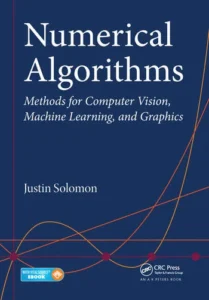
13. Numerical Algorithms: Methods for Computer Vision, Machine Learning, and Graphics by Justin Solomon
Justin Solomon’s Numerical Algorithms is a modern masterpiece that unifies computational techniques across computer vision, machine learning, and graphics. Published by CRC Press, this book dives into the numerical methods powering cutting-edge applications, from image processing to 3D rendering. Solomon’s clear prose and focus on practical implementation make complex algorithms approachable. The text is lauded for its balance of mathematical rigor and real-world relevance, appealing to both theorists and practitioners. With code examples and exercises, it’s a hands-on guide for mastering computational challenges. This book is a must-read for those shaping the future of visual technologies.
What Will You Learn:
- Numerical methods like optimization, eigenvalue problems, and interpolation.
- Applications in image processing, 3D reconstruction, and machine learning.
- Techniques for solving computational problems in vision and graphics.
Who is This Book For:
- Graduate students and researchers in computational fields.
- Professionals seeking numerical methods for vision and machine learning
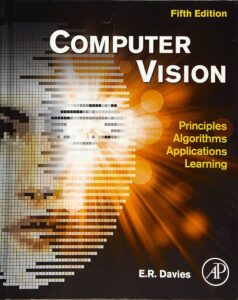
14. Computer Vision: Algorithms, Applications, Learning by E. R. Davies
E. R. Davies’ Computer Vision: Algorithms, Applications, Learning, published in 2017 by Academic Press, is a comprehensive guide to the field’s core principles and modern advancements. This fifth edition integrates classical algorithms with machine learning techniques, covering topics from edge detection to deep learning. Davies, a seasoned academic, excels at balancing theory with practical applications like industrial inspection and surveillance. Its clear explanations and updated content make it accessible yet thorough. The book’s broad scope makes it a valuable resource for students and professionals alike. It’s an excellent choice for those seeking a well-rounded vision education. The book offers a blend of classical and modern vision techniques. Its practical focus ensures real-world relevance.
What Will You Learn:
- Classical vision algorithms like edge detection and texture analysis.
- Machine learning techniques, including neural networks for vision tasks.
- Applications in industrial, medical, and surveillance systems.
Who is This Book For:
- Students and educators seeking a comprehensive vision textbook.
- Professionals applying vision in practical, industry-specific contexts.
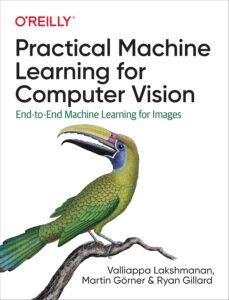
15. Practical Machine Learning for Computer Vision by Valliappa Lakshmanan, Martin Görner, and Ryan Gillard
Practical Machine Learning for Computer Vision, published in 2021 by O’Reilly Media, is a hands-on guide by Valliappa Lakshmanan, Martin Görner, and Ryan Gillard. This book focuses on building vision systems using TensorFlow, covering tasks like image classification and object detection. Its project-based approach and cloud-based workflows make it highly relevant for industry practitioners. The authors’ clear explanations and real-world examples ensure accessibility for intermediate learners. It emphasizes scalable, production-ready solutions, setting it apart from purely academic texts. This book is ideal for those aiming to deploy machine learning in vision applications. The book teaches practical, scalable vision solutions. Its focus on TensorFlow and cloud computing aligns with industry needs.
What Will You Learn:
- Machine learning workflows for vision using TensorFlow and Keras.
- Techniques for image classification, segmentation, and video analysis.
- Cloud-based deployment of vision models for scalability.
Who is This Book For:
- Intermediate programmers with machine learning experience.
- Data scientists and engineers building production-ready vision systems
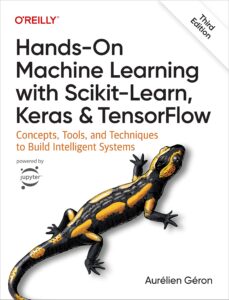
16. Hands-On Machine Learning with Scikit-Learn, Keras, and TensorFlow by Aurélien Géron
Aurélien Géron’s Hands-On Machine Learning with Scikit-Learn, Keras, and TensorFlow, published in 2019 (second edition) by O’Reilly Media, is a bestselling guide to machine learning with a strong vision component. This book covers the full machine learning pipeline, from data preprocessing to deep learning, with practical vision applications like image classification. Géron’s engaging style and hands-on projects make complex concepts approachable. Using Scikit-Learn, Keras, and TensorFlow, it ensures industry-relevant skills. Its comprehensive scope and clear code examples make it a favorite among learners. This book is perfect for those seeking a practical, vision-inclusive machine learning education. The book teaches end-to-end machine learning with a focus on vision tasks. Its hands-on approach suits practical learners.
What Will You Learn:
- Machine learning fundamentals using Scikit-Learn and TensorFlow.
- Deep learning techniques for vision, including CNNs and image processing.
- Practical model building, evaluation, and deployment workflows.
Who is This Book For:
- Programmers with basic Python knowledge new to machine learning.
- Data scientists and engineers working on vision and machine learning projects.
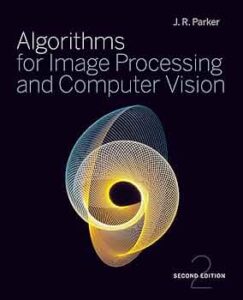
17. Algorithms for Image Processing and Computer Vision by J. R. Parker
R. Parker’s Algorithms for Image Processing and Computer Vision, published in 2010 by Wiley, is a practical guide to classical vision algorithms. This book focuses on implementing techniques like edge detection, morphology, and texture analysis, with code in C and Java. Parker’s clear explanations and algorithmic focus make it accessible to programmers seeking hands-on skills. Its emphasis on traditional methods complements modern deep learning texts, though it lacks newer advancements. The book’s detailed examples and exercises ensure a solid learning experience. It’s a valuable resource for those mastering foundational vision algorithms. The book teaches practical implementation of classical vision techniques. Its code-heavy approach suits hands-on learners.
What Will You Learn:
- Classical algorithms for edge detection, segmentation, and texture analysis.
- Image processing techniques like filtering and morphological operations.
- Implementation of vision algorithms in C and Java.
Who is This Book For:
- Programmers with basic coding skills interested in classical vision.
- Students and developers seeking to understand traditional vision algorithms.
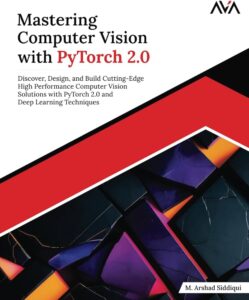
18. Mastering Computer Vision with PyTorch 2.0 by M. Arshad Siddiqui
Mastering Computer Vision with PyTorch 2.0 by M. Arshad Siddiqui, published in 2023, is a cutting-edge guide to building vision systems with PyTorch’s latest version. This book dives into deep learning techniques, from CNNs to vision transformers, with practical projects like object detection and image generation. Siddiqui’s clear, code-driven approach ensures readers can implement advanced models effectively. Its focus on PyTorch 2.0’s new features, like dynamic computation graphs, keeps it ahead of the curve. The book’s hands-on projects and industry relevance make it a standout. It’s ideal for those aiming to master modern computer vision with PyTorch. The book teaches advanced vision techniques using PyTorch 2.0. Its project-based focus ensures practical, up-to-date skills.
What Will You Learn:
- Deep learning techniques, including CNNs, GANs, and vision transformers.
- Practical applications like object detection, segmentation, and image synthesis.
- Leveraging PyTorch 2.0’s features for efficient model development.
Who is This Book For:
- Intermediate Python programmers with machine learning experience.
- Developers and data scientists focused on cutting-edge vision applications.
19. Deep Learning for Computer Vision with Python by Adrian Rosebrock
Adrian Rosebrock’s Deep Learning for Computer Vision with Python, first published in 2017 by PyImageSearch, is a highly regarded guide for building practical computer vision applications using deep learning. This book stands out for its code-first, hands-on approach, guiding readers through real-world projects like image classification, object detection, and face recognition. Rosebrock’s clear explanations and extensive Python code examples, leveraging libraries like TensorFlow and Keras, make complex concepts accessible. Its focus on actionable tutorials and downloadable code bundles ensures immediate applicability, earning praise from practitioners. While it assumes basic Python knowledge, its practical bent makes it a favorite among developers. This book is a must-have for anyone looking to master deep learning in computer vision with a project-driven mindset.
The book empowers readers to build robust vision systems through practical exercises. Its emphasis on real-world applications ensures skills are immediately usable.
What Will You Learn:
- Deep learning techniques for image classification, object detection, and face recognition.
- Practical implementation using Python, TensorFlow, Keras, and OpenCV.
- Strategies for training and optimizing neural networks for vision tasks.
Who is This Book For:
- Programmers with basic Python skills seeking practical deep learning experience.
- Data scientists and developers building vision applications for real-world use.
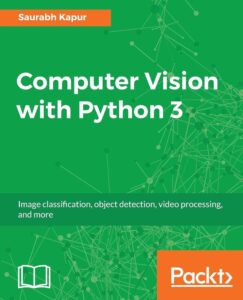
20. Computer Vision with Python 3 by Saurabh Kapur
Computer Vision with Python 3 by Saurabh Kapur, published in 2018 by Packt Publishing, is a popular and accessible introduction to computer vision for Python developers. This book shines for its straightforward approach, guiding readers through core vision techniques using Python libraries like OpenCV, NumPy, and Matplotlib. Kapur’s focus on practical applications – such as image processing, object detection, and facial recognition – makes it ideal for hands-on learners. Its step-by-step tutorials and clear code examples cater to those new to the field, while still offering value to intermediate coders. Though it lacks the depth of more advanced texts, its beginner-friendly style and relevance to modern Python ecosystems make it a go-to choice. This book is perfect for anyone starting their computer vision journey with Python. The book teaches essential vision skills through practical Python-based projects. Its beginner-oriented approach ensures a smooth learning curve.
What Will You Learn:
- Core computer vision techniques, including image filtering, edge detection, and feature extraction.
- Practical applications like object detection, image stitching, and facial recognition.
- Effective use of Python libraries such as OpenCV, NumPy, and Matplotlib.
Who is This Book For:
- Beginners with basic Python knowledge new to computer vision.
- Developers seeking to build practical vision applications with Python.
Conclusion
Computer vision isn’t just a buzzword – it’s powering everything from facial recognition in your phone to self-driving cars. And whether you’re a curious beginner or a seasoned developer, the right book can make all the difference in understanding how it all works.
From hands-on guides like Programming Computer Vision with Python to academic heavyweights like Multiple View Geometry in Computer Vision, there’s truly something here for every kind of learner. Want to get practical with PyTorch? Dive into Modern Computer Vision with PyTorch. Looking for solid theoretical foundations? Computer Vision: Models, Learning, and Inference or Szeliski’s Algorithms and Applications are excellent picks.
The world of computer vision is evolving fast – but a good book is still one of the best ways to build strong, lasting knowledge. Pick the one that fits your goals, and you’ll be on your way to seeing the world like a machine.
